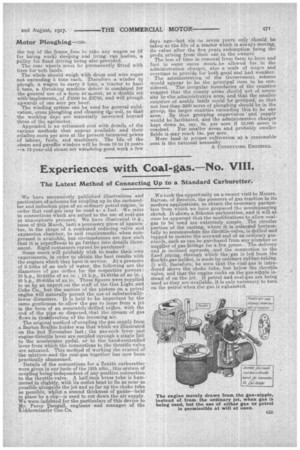Experiences with Coal-gas.—No. VIII.
Page 7

If you've noticed an error in this article please click here to report it so we can fix it.
The Latest Method of Connecting Up to a Standard Carburetter.
We have successively published illustrations and particulars of schemes for coupling up to the carburetter and induction pipe of an ordinary petrol er(gine, in order that coal-gas may be used a.: a fuel. We refer to connections which are suited to the use of coal-gas at atmospheric pressure. We have illustrated (e.g., issue of 29th March, last) a necessary piece of apparatus, in the shape of a combined reducing valve and expansion chamber, to suit requirements when compressed is available, but circumstances are now such that it is superfluous to go further into details thereanent. Rigid containers cannot be purchased Some users will probably wish to make their own experiments, in order to obtain the best results with the engines which they have in service. At a pressure of 9-10ths of an inch of water, the following are the diameters of gas orifice for the respective powers: 10 h.p., 20-64ths of an in. ; 15 h.p., 24-64ths of an nn.; 20 h.p., 28-64ths of an in. These figures were supplied to us by an expert on the staff of the Gas Light and Coke Co., but the suction of the pistons on a. petrol engine will naturally permit the use of substantiallylower diameters. It is held to be important by the same gentleman to allow the gas to issue from a jet in the form of an accurately-drilled orifice, with the end, of the pipe so disposed that the stream of gas flows in theddirection of the incoming air.
The original method of-coupling the gas supply from a Barton flexible holder was that which we illustrated on the 2nd November last ; the gas-cock lever and engine-throttle lever are coupled through a single link to the accelerator pedal, or to the hand-controlled lever from which the connections to the throttle-valve are actuated. This method of working the control of the mixture .and the coal-gas together has now been practically abandoned.
Details of the connections for a Zenith carburetter were given in our issde of the 12th ulto., this system of coupling being independent of any positive connection to the throttle-valve. A half-inch brass tube is hammered in slightly, with its outlet bent to lie as near as possible alongside the jet and as far up the choke tube as possible, whilst a second thickness of gauZe—held in place by a clip—is used to cut down the air supply. We were indebted for the particulars of this device to Mr. Percy pougall. engineer and manager of the Kidderminster Gas Co.
We took the opportunity on a recent visit to Messrs. Barton, of Beestqn, the pioneers of gas traction in its modern applications, to obtain the necessary particulars from which we have prepared the accompanying sketch. It shows a Sthenos carburetter, and it will at once be apparent that the modifications to allow coalgas to be used, are extremely simple. The circular portion of the casting. where it is enlarged horizontally to accommodate the throttle-valve, is drilled and tapped to receive the screwed end of an ordinary gasnipple, such as can be purchased from any plumber or supplier of gas fittings for a few pence. The delivery end is inclined upwards, and the connection to the fixed piping, through which the gas is led from the flexible gas-holder, is made by ordinary rubber-tubing. It will, therefore, be seen that the coal-gas is introduced above the choke tube, but below the throttle valve, and that the engine sucks on the gas-nipple instead of on the jet. If petrol and coal-gas are being used as they are available, it is only necessary to turn on the petrol when the gas is exhausted.




















